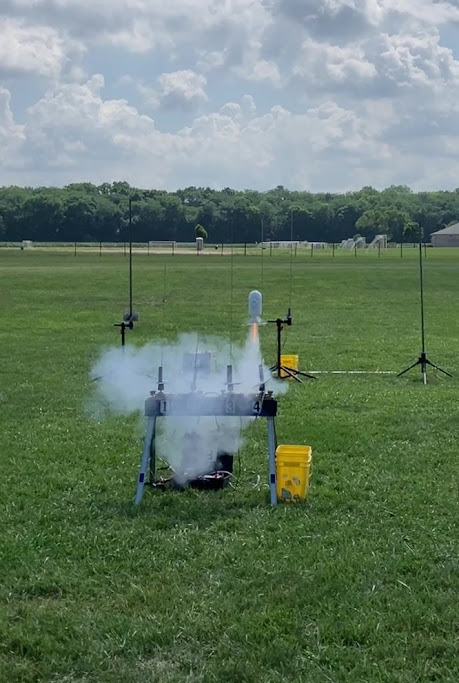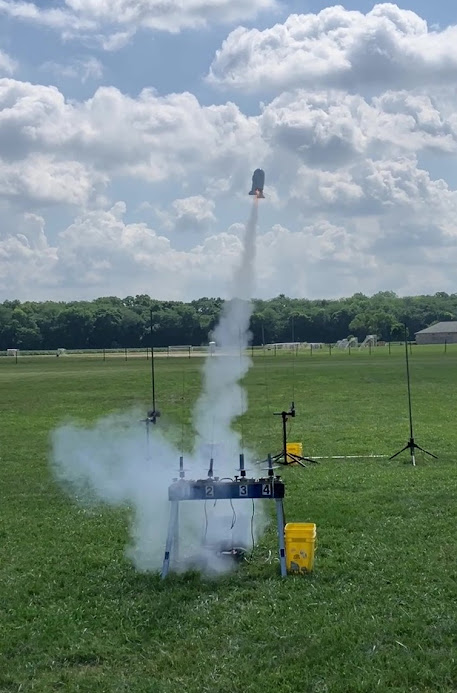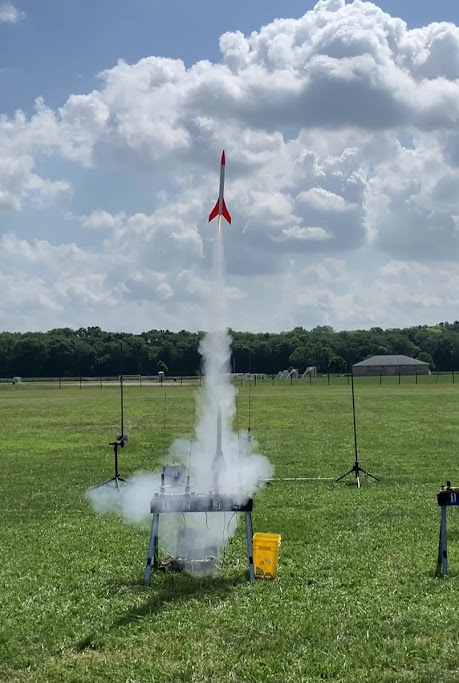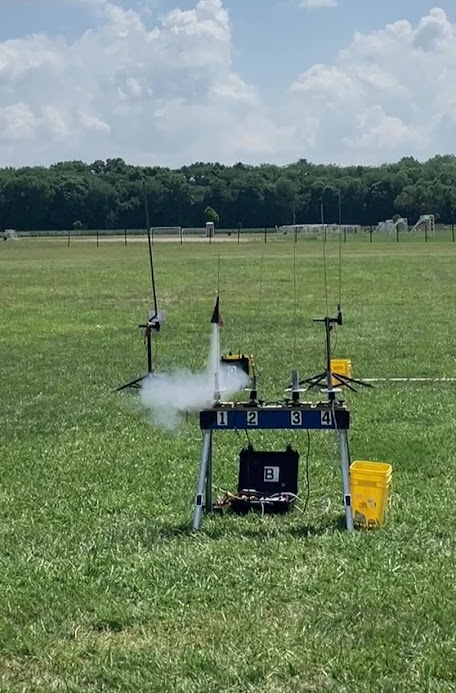As the cool kids say, it's been a minute since I flew with the Wright Stuff Rocketeers. They've been back to eRockets Field since late spring, but cruise vacations, air shows and plain ol' bad luck have kept me from being able to make the trip to Huber Heights in 2025. Midway through July I'm happy to report that I've exorcised that particular demon.
Saturday, July 12 was a scorcher. (It's also my sister's birthday. Happy birthday, Jen.) I arrived at the field in what I thought would be plenty of time to help with the setup, only to find the setup done and the crowd sparse. I also found wind, something that hadn't been expected until later in the afternoon when the rains blew in. (SPOILER ALERT: It wouldn't be that much later.) After a quick flyer's meeting under Mike's canopy, we got down to flying.
Once again, I'd packed a box of never flown and not flown in years birds, with a few gliders of recent creation thrown in just to get them some airtime on the big field. I chose my newly flightworthy Estes R2D2 as my first flight. This is an original 1977 version that I bought via eBay back in the early 2000's. I had read enough about them online to know that the smart money was on an engine upgrade, so little by little I got along with the construction. 20ish years passed before a vacation a couple of weeks ago when we planned to spend three days in the pool, only to find that Mother Nature had other plans. I spent a lot of time in the shop and R2 was one of the kits that came out flyable.

To say that this flight didn't cause me some nerves would be lying. I knew the switch from 18mm to 24mm would change the flight characteristics, so I overcompensated on nose weight. A string test was attempted, but didn't tell me much, so I painted it and hoped for the best. I got it. As expected, the D12 was plenty powerful. Unfortunately, the same can't be said for the 48-year-old plastic. R2 windcocked to the right off the pad and topped out at 214'. At ejection another of the issues with the design came to light as the parachute suffered some fairly serious burns despite being packed well out of the way of the blast. The 18' chute still tried to bring things down in one piece, but it was parawad at best and the impact with the ground was pretty harsh. Sure enough, I found one of the plastic fins broken off when I got to the landing spot. Looks like an easy fix, but like a lot of the Star Ways birds I don't really see this being a frequent flyer.






Flight #2 would be the eagerly awaited first flight of my FRW Uproar, a scrap box bird built for use in the corn. No corn here except for across the creek, and the breeze wasn't heading that way. Still, I went with a D12-5 to keep it on the field. I guess I should have used a C6-5.

Things started out bad. Instead of the big windcock I'd expected, the Uproar left the pad heading dead straight. That, along with the 900+' altitude spelled trouble. The flight itself was perfect and I'd used one of my smaller nylon chutes for the flight. It popped just after it tipped over to the delighted howls of the flightline. The parachute matched my shirt, and my phone case, and on some days my shoes, but not today. From its position straight overhead, it began drifting quickly toward the long end of the field. It was clearly going to be a long walk for me and Dave and I were taking bets about where on the field it would land. I bet midfield on the Wayne Pee Wee football field while Dave bet on it splitting the uprights. It turned out not to be a long walk at all. We were both surprised when it disappeared behind the trees and was lost forever in the quarry. Maybe it's hanging out talking shop with my USR Supersonic. Maybe Jerry is cackling "MORE POWER!" in a gleeful voice.




Flight #3 would be my first non-B6-4 Field flight of my Estes D.O.M. Flying Jennie, mostly because of my sister's birthday. Unlike the B6-4 Field load which was always either a 1/2A6-2 or A8-3, this one would be on a B4-2, so I was looking forward to seeing how it flew with legs stretched.

As gliders go, this is a fun little rocket. It's built out of shop scraps like the Uproar, but not likely to get lost on a B4-flight. I tried to color it with markers just to keep the weight down. That's been tough for me. Harnessing the focus to finish the marker job with my meager patience has been a chore, as you can see. I never did well with coloring in school either. That said, this was a fairly quick, simple build and it flew well from the start, so I was pretty confident that it would avenge the loss of the Uproar. Things didn't start all that well. Jennie left the pad and arced back over the flightline to our left, heading in the general direction of Rip Rap Road. Rip Rap Road and I have a long and ugly history with multiple lost rockets happening in the vicinity, but this one didn't have enough motor behind it to join the crowd. The flightpath resembled a very quick ?, but at ejection Jennie settled into a tight, circular path. It made one big circle and began heading back toward the football field, crossing back over the flightline and dropping ever closer to the grass before landing gently. It was my first damage-free flight of the day.




With the strong, steady breeze keeping any more altitude flights grounded, I chose another glider for flight #4, the FRW Dingbat. Essentially a slightly larger version of the AMROCS Wombat that it was supposed to have replaced, the Dingbat needed its own identity when I was able to successfully repair the broken Wombat.
The Dingbat flight wasn't what I'd expected. It windcocked heavily off the pad to the right at a steep angle and didn't quite crack the 100' mark. As a result, the forward motion stalled when the ejection charge fired. This happened less than 30' from the ground and the Dingbat fluttered to earth, unable to recover the forward motion necessary for any gliding to commence. Kinda disappointing after the excellent first flight a few weeks back. Did I say disappointing? This would be a shining success after the next flight. Sorry, "flight".
"Flight" #5 would be another glider, this one a real garbage skow of second hand parts, the Jet Freak 4. For a while, it seemed that I'd build a Jet Freak whenever I turned up a BNC-20 of appropriateish length. I've killed a couple, lost a couple, and I still have a couple flying. (Actually, three before this "flight".)
As you can see, 4 hadn't lead an easy existence. I tried the marker route on it and killed the first marker. Then the next one couldn't be bothered to match and eventually almost faded away completely. In the none-too-distant past all of my Jet Freaks were just called Jet Freak, but it began to be tough to tell which one was making which flight in the RocketReviews flight logs, so the remaining three got numbers. Hence, the 4. This would be a B4-2 flight, as far as I know the first ever for one of my Freaks. Found out why.
Things looked normal as it left the pad. It windcocked right like every rocket except the one I really wanted to see go that way. We had an eye on it and things looked normal until they didn't. There was a definite issue at the end of the boost, evidenced by the sound of a motor going end over end. Then something happened, and I was able to see something falling. Thinking it was the Freak glide phase kicking in, I kept the camera on it. It landed behind me on the flightline. It was the expended motor. We immediately began scanning the skies for the glider but saw nothing. Finally, when it was obvious that the glide hadn't occurred, Dave, Mike and I did a CSI walk-through of the field downwind. The first thing we found was the engine tube, pylon and nose cone. Then one by one, the other five pieces were located. We actually found the whole carcass. Jet Freak 4 is officially retired. There will be a gathering in meeting room 7. Cookies will be served.





The Cosmik Debris last flew in 2007 at the NSL in Muncie. It wasn't a rousing success. It got caught on the rod, managed to clear and nosed into the ground effectively destroying itself. That should have been the end, but there were a lot of parts and time invested in the project, so I didn't feel like I could just toss it out. If it looks familiar, it's because it was featured in the Estes Custom Parts Catalog in 1974 showing what you could make with Estes parts and your imagination. I brought it up at YORF and was told I couldn't get it off the rod, so of course I ordered the parts. I built it and flew it on a C6-3, a fairly lethargic flight. Then I made the mistake of listening to Lee Berry and Mark Fisher who suggested an 18mm D21-4. Yeah, it got off the pad better. It also reached the speed of balsa before it hit 100'. Somehow it was rebuilt and now rebuilt again. I had higher hopes for the C5-3.

The over-under on how many Alphas could be built using the balsa from those fins is 14. That might eventually happen. Like I said, this flight would be on a C5-3, which should hopefully make for a more majestic trip up the rod. Or not. I could post the pics, but the video sells it a lot better.
Moving on. Next up is an obscurity, a Shecter Streamer Duration Rocket that I purchased open and decided to build. Not sure exactly when Fred kitted these, but I've been seeing them on eBay recently. Someone must have found a stash.
Excellent altitude on the A8-3. Ejected the motor and came in ballistic. Post-holed the field. At first I thought my glue joint that connects the shock cord to the fin had failed and let the nose cone sail off on the streamer. That wasn't the case. The nose cone buried itself about two inches into the field. Other than some slight deforming of the body tube there was no damage. Upon inspection it appeared that the shock cord had caused the nose cone to fit a bit too tight and the motor blew out instead of launching the streamer.




The next flight would be a three-stager, the MPC Microsonde 3 Payloader. I figured this would be a decent pick because it had been loaded with a fairly conservative A8-0/A8-0/A8-5 load. This was another rocket that spent a lot of time waiting to get into the paint booth before my recent vacation, mostly because I had no idea what color scheme to go with. In the end, I always seem to wind up with orange, white and black. This time I threw in some silver just to break things up a bit.
Who doesn't love a multi-stage flight, especially when there are three? My worries about the A8-0 having the power to lift the Microsonde disappeared immediately. It left the pad leaning into the wind and off to the right, then staged before it reached 100'. Second stage went not long after and we scanned the skies for the sustainer but didn't see it. I decided that my best option was to walk the field to my left and found it a couple of hundred feet out. It had cracked a fin on impact, ironically the same one that I'd cracked off while sanding. Should be an easy fix. The flight did dispel any notion I had of flying it at B6-4 Field. Even on an A8 stack, it would be too much.





I didn't know it at the time, but the Jet Freak 5 would be my last flight of the day. Unlike the retired guys launch a few months back, I had come prepared for the full sun and heat with a cooler full of Powerade. I was well hydrated, but still hot, but I still had some flights left in me. I chose another glider for ease of recovery only to have 5 take me on the longest recovery walk of the day.

The "easy recovery" flight on a B4-2 started innocently enough, boosting right off the pad into the breeze and quickly going out of sight. The whole flightline scanned the skies for the circling bird, but we saw nothing. I was ready to give up and start a grid search when one of the young girls at the end of the flightline mentioned that she tracked it and it landed on the soccer field. I was doubtful but headed off into the direction she pointed. I walked right up to the glider. It was upside down, so the neon orange didn't provide much visibility, but the blue did it's best not to blend in. I let her know how much her young eyes were appreciated after my walk, then attacked the Powerade. While I was drinking, Mother Nature called an end to the day with a thunder crack off to the west.




Still, not a bad day of flying, even with the winds. I managed to take all but one home with me and, truth be told, I really had run out of rockets to fly safely in the windy condition. I had two more multi-stage rockets prepped and ready, both B6-0/B6-6 which would have probably been survivable, as well as my Semroc Oso on a C6-5. I'd have flown all three without a second thought. As it is, I have three rockets prepped for our next launch. I'm also toying with the idea of a D-powered version of the Jet Freak, just for cheap thrills. Pretty sure I have enough scrap balsa, BT-50 and a nose cone.










































I have always enjoyed flying the Jet Freak. It's such a quick build, maybe I need to have a fleet of them, too?
ReplyDeleteI am impressed with the "all A engine" launch of the Microsonde. Also impressed that the only fin damage was on a previously cracked fin. With mostly hard ground here, pointy fins are not often used. Nice report, as usual.
I replaced the previously damaged fin. I could tell this one was the replacement because it was sanded a bit different.
ReplyDelete